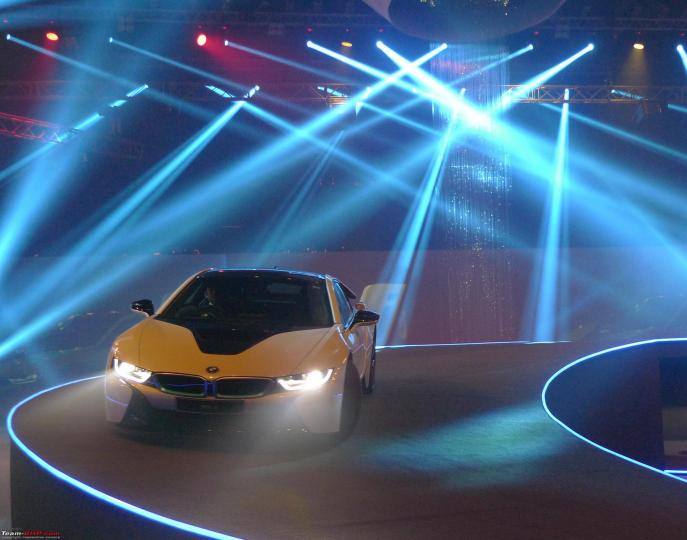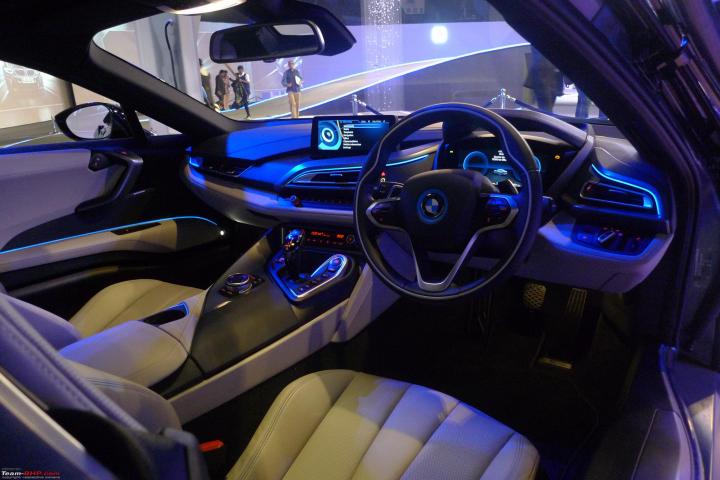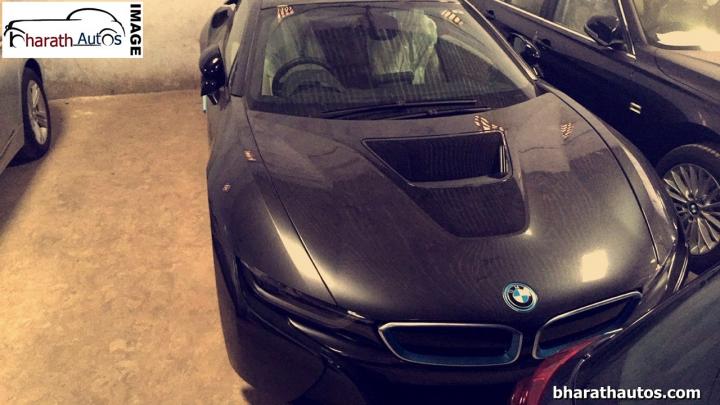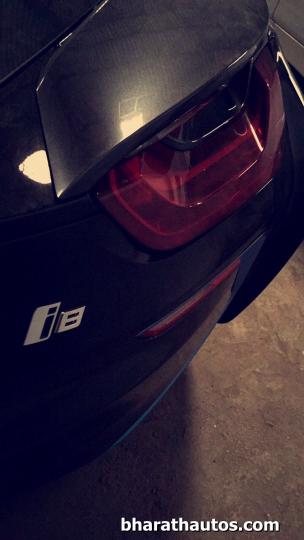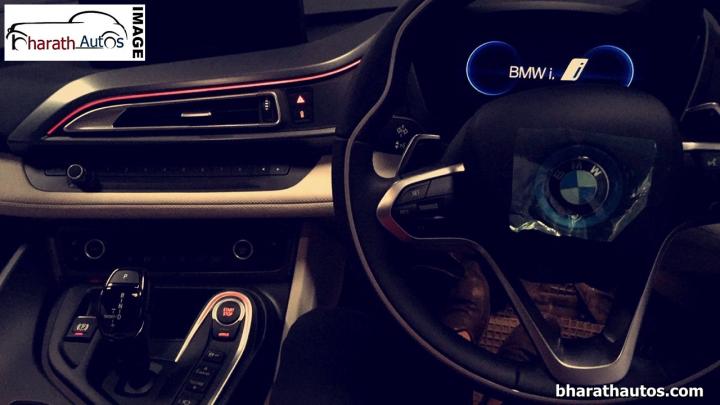News
BMW teases i8 Roadster, to go on sale next year
BMW has teased the convertible version of its hybrid sports car - the i8 Roadster. The car is expected to be unveiled later this year, while sales will likely commence sometime next year.
The i8 Roadster was first unveiled as a concept car, though it took over 4 years for BMW to bring the car into production. It was only last year when the company confirmed that it will be producing a convertible version of the i8. The released teaser video shows a camouflaged mule of the i8 Roadster, parked inside a wind tunnel. In addition to the chopped off roof, the i8 Roadster will also come with some new design elements, that are expected to be introduced in the coupe version as well in 2018.
There is also a possibility of some tweaks in the powertrain department, which might bump up the output to around 395 BHP, from the 352 BHP currently available with the coupe. However, the overall powertrain layout is expected to remain unchanged. As a result, a 3-cylinder engine will power the rear wheels while an electric motor will supply juice to the front wheels.
- Tags:
- Indian
- BMW i8
- BMW i8 Roadster
News
BMW i8 hybrid supercar launched at Rs 2.29 Crore
BMW India has launched the i8 hybrid supercar at an all India ex-showroom price of Rs 2.29 Crore. The i8 will be sold through BMW i dealerships in Mumbai, Delhi and Chennai. The car will be brought to India as a direct import and all servicing work, including repairs to carbon fiber components can be carried out in India.
The i8 is powered by a 1.5-liter, 3-cylinder, BMW TwinPower turbo engine that powers the rear wheels. The engine is complimented by an electric motor that propels the front axle. There's also a small electric motor integrated into the main engine that provides an "e-boost" of around 10 BHP in high performance scenarios. The internal combustion engine produces 228 BHP @ 5,800 rpm and 320 Nm of torque @ 3,700 rpm. The electric motor produces 129 BHP and 250 Nm of torque. The combined output comes in at 357 BHP/570 Nm which propels the car from 0-100 km/h in a claimed 4.4 seconds. The electric motor is mated with a 2-speed automatic transmission, while the main engine is mated with a 6-speed automatic.
On battery power alone it manages a range of 35 kms and can hit a top speed of 120 km/h. With both motors working, the i8 can hit a top speed of 250 km/h. The combined range stands at 600 kms, while combined fuel economy is around 45 km/l. Colour options include crystal white pearl effect with highlight BMW i blue, protonic blue with highlight frozen grey metallic, sophisto grey brilliant effect with highlight BMW i blue and the ionic silver with highlight BMW i blue.
News
BMW to launch i8 in India on February 18, 2015
Earlier this month, the BMW i8 hybrid had been spotted at a dealership in Mumbai, leading to speculation that the launch of the car was not too far. Now, the German carmaker has revealed that it will launch the car in India on February 18, this year.
The i8 features a 2-door coupe body that is built with an extensive use of carbon fibre and weighs 1,485 kg. The whole drivetrain, suspension and battery pack rests on an aluminium frame. The i8 is equipped with features such as scissor doors, LED & laser headlamps, LED tail lamps, 20-inch alloy wheels and shark fin antenna. The interiors of the car feature carbon fibre-reinforced plastic and feature a 3-spoke steering wheel, head-up display and ambient lighting among other equipment.
Powering the i8 is combination of an electric motor and a 3-cylinder petrol engine. The electric motor develops 131 bhp and 320 Nm of torque and sends power to the front axle. The car's 1.5-litre turbocharged petrol engine produces 231 bhp and 250 Nm of torque and powers the rear axle. The combination of the petrol engine and electric motor helps the i8 sprint from 0 to 100 kph in a claimed 4.4 seconds, while the top speed of the car is pegged at 250 kph. BMW claims that the car has a range of 600 km. Using just the batteries, the i8 can hit a top speed of 120 kph with a maximum range of 37 kms.
BMW will bring the i8 to India through the CBU route, which means, we can expect an eye-watering price tag.
News
BMW i8 at dealership in India: more images
Earlier this month we had reported that the BMW i8 hybrid had been spotted at the stockyard of a dealership in Mumbai. Now another i8 has been spotted, again at a dealership.
BMW had displayed the i8 in India at the 2014 Auto Expo. The car is powered by a combination of an electric motor and a 3-cylinder petrol engine. The electric motor develops 131 bhp and 320 Nm of torque and sends power to the front axle. The rear axle draws power from a 1.5-litre turbocharged petrol engine that puts out 231 bhp and 250 Nm of torque. This combination helps the i8 achieve claimed 0 to 100 kph time of 4.4 seconds and reach a top speed of 250 kph. It has a claimed range of 600 km. Running on the batteries alone, the i8 can reach a top speed of 120 kph with a maximum range of 37 kms.
The i8's body uses a lot of carbon fibre and weighs 1,485 kg. The passenger cabin is made from carbon fibre-reinforced plastic, while the whole drivetrain, suspension and battery pack rests on an aluminium frame. The i8 is equipped with features such as scissor doors, LED & laser headlamps, LED tail lamps, 20-inch alloy wheels, shark fin antenna, 3-spoke steering wheel, and ambient lighting among others.
Only eight units of the i8 have been allocated to India for 2015. The car is expected to be launched in February.
Source: Shifting-Gears
News
CES 2015: BMW i Home Charging Services revealed
BMW unveiled the i Home Charging Services at the Consumer Electronics Show (CES) 2015. The system has been developed for home charging of electric and plug-in hybrid BMW models. Jointly developed by BMW and Beegy, a provider for distributed energy-management, the carport concept is based on the i Wallbox Pro setup that BMW revealed in September, 2014.
The charging service can support both solar and grid power charging. BMW claims the solar carport with a roof area of 25 square metres or more can produce enough power for 32,000 kilometres of electric driving annually. The vehicle is charged with home-generated solar power whenever it is available. When solar energy is unavailable, the vehicle is automatically charged at the "cheapest off-peak rates". This makes it possible to take advantage of flexible electricity pricing that varies depending on the time of day in markets like the USA. BMW says this could save U.S. customers up to $800 (approximately Rs 50,000) a year.
Systems such as this one are being introduced as brands are looking to provide an impetus to their electric vehicle portfolio. While BMW hasn't announced any plans regarding the i3 for India, the i8 will be launched in our sub-continent in 2015.
News
BMW i8 reaches Mumbai dealership ahead of launch
The BMW i8 hybrid has been spotted at the stockyard of a dealership in Mumbai. BMW had displayed the car at the 2014 Auto Expo.
The i8 has a body that uses a lot of carbon fibre and weighs 1,485 kg. The passenger cabin in the i8 is made from carbon fibre-reinforced plastic, while the whole drivetrain, suspension and battery pack rests on an aluminium frame.
The i8 uses a combination of an electric motor and a 3-cylinder petrol engine. The electric motor produces 131 bhp and 320 Nm of torque and powers the front axle. The rear axle is powered by a 1.5-litre turbocharged petrol engine that puts out 231 bhp and 250 Nm of torque. This combination helps the i8 to do a 0 to 100 kph sprint in 4.4 seconds and achieve a top speed of 250 kph. It has a claimed range of 600 km. Using just the batteries, the i8 can hit a top speed of 120 kph with a maximum range of 37 kms.
The launch of the i8 in India is rumoured to be next month. The car will be brought to the country through the CBU route. Only 8 units have been allocated to India for 2015.
Source: Bharat Autos
News
Video: BMW i coming to India
BMW India is gearing up to introduce cars using hybrid technology, dubbed "i", in India. Akshay Sarode brings to our notice an advertisement that BMW has put up on its youtube channel.
If reports are to be believed, the company will display its i8 sports coupe at the Auto Expo in February. The car, which was unveiled at the 2013 Franfurt Motor Show, sports a 1.5-litre, TwinPower turbo, 3-cylinder, petrol engine, which pumps out 231 PS and 320 Nm of torque. The car’s electric motor develops an additional 131 PS and 250 Nm taking the car’s total power output to 362 PS and 570 Nm. BMW claims a 0-100 kph time of 4.5 seconds and a top speed of 250 kph for the i8.
Only eight units of the i8 have been allocated to India and deliveries are not expected to commence before late 2014.
News
BMW India to assemble 3 Series GT from 2014
BMW India will infuse an additional 210 crore rupees into its Chennai factory in order to expand production. The expanded production, which will take BMW India's installed capacity to 14,000 cars/year, will include an assembly line for the 3-Series GT, a car that will be launched here in 2014. The 3-Series GT is a more spacious variant of the F10 3-Series range and the new car will sit between the 3-Series and 5-Series BMW saloons that the German luxury car maker sells in India.
The BMW 3-Series GT is likely to be made available only with turbo diesel engines given the Indian luxury car buyers' penchant for diesel engined cars. CKD assembly of the BMW 3-Series GT is likely to keep the car relatively affordable, with the car's price sandwiched between those of the 3-Series and 5-Series saloons. Earlier reports suggested that BMW India was looking at the CBU import route for the 3-Series GT, a move that would have made the car quite expensive, rivaling the 5-Series in terms of pricing.
BMW is also considering the launch of the i3 electric and the i8 hybrid cars in India. While the i3 is an all-electric car and one that was launched internationally earlier this year, the i8 Hybrid is a sportscar that uses a 1.5 liter, turbocharged petrol engine and an electric motor to make for high performance. The i8, unveiled at this year's Frankfurt Motor Show, will go on sale internationally next year. Both cars, if green lighted for India, are likely to be imported through the completely built unit (CBU) route as the sales numbers will be too low to justify local assembly. These cars will serve as showcases of BMW's electric and hybrid vehicle technology, and function primarily as brand builders.
While the Indian government has formulated a National Electric Mobility Mission Plan (NEMMP) 2020, in order to encourage the manufacture and sales of electric and hybrid cars to reduce the country's dependence on fossil fuels, the subsidies promised under this plan are yet to take off. So, until the government takes positive steps on the subsidy structure, car makers such as BMW and Toyota might sit on the fence before introducing their high performance electric and hybrid cars.
Source TheEconomicTimes
- Tags:
- Indian
- BMW 3-Series GT
- BMW i3
- BMW i8




